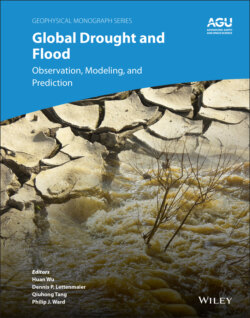Читать книгу Global Drought and Flood - Группа авторов - Страница 38
2.4.3. GET‐D System Outputs
ОглавлениеFigure 2.3 presents an example of the 2/4/8/12‐week composite of ESI generated from the GET‐D system at 8 km resolution over the North American domain on 22 September 2016. Near‐real time GET‐D data products based on GOES‐13 and GOES‐15 observations before 30 December 2017 were available from https://www.star.nesdis.noaa.gov/smcd/emb/droughtMon/products_droughtMon.php. GET‐D products based on GOES‐16 and GOES‐17 are being upgraded to higher spatial resolution and will be available to the public. Figure 2.4 gives an example of the 2‐week ESI 2012 central United States flash drought between early June and mid‐August, compared with a precipitation index and the U.S. Drought Monitor index. The ESI represents standardized anomalies in the ET/PET ratio: negative anomalies indicate drier than normal conditions, whereas positive anomalies indicate wetter conditions. Large negative Rapid Change Index (RCI; Otkin et al., 2014) values in the top row indicate that moisture stress was rapidly increasing at the beginning of the summer. Impressive scope of the unusually rapid decrease in the ESI anomalies is clearly depicted by the large area of negative RCI values (see the circled area in the two columns at the right of Figure 2.4). Notably, initial appearance of negative RCI values led the introduction of severe drought in the U.S. Drought Monitor by more than 4 weeks.
Figure 2.3 The 2/4/8/12‐week composite of ESI generated from the GET‐D system at 8 km resolution over the North American domain on 22 September 2016. OSPO, Office of Satellite and Product Operations. GET‐D data products based on GOES‐13 and GOES‐15 observations before 30 December 2017 were available from https://www.star.nesdis.noaa.gov/smcd/emb/droughtMon/products_droughtMon.php
(Source: National Oceanic and Atmospheric Administration, ESI generated from the GET‐D system, September 22, 2017.)
